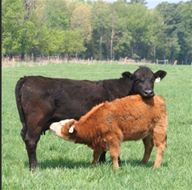



Spring Tips for Beef Cattle Farmers
Cattle deworming, crabgrass planting, rotational grazing and reproduction programmes should all be under way now, according to the University of Arkansas, Department of Animal Science.Cattle at this time could be exhibiting signs of grass tetany as they are put back on pasture, while grassland may need scouting for worms, advises the extension service at the University of Arkansas.
• With the beginning of the breeding season monitor the activity of each bull. Be sure all bulls are walking properly and checking cows for estrus activity. Sometimes bulls can become lame or injured which could affect their ability to locate and breed cows. Feet, legs, penis, front shoulder, hip and eyes are few areas that can get injured affecting a bull's ability to breed cows.
• For a fall calving herd, it may be time to vaccinate replacement heifers for Brucellosis. The proper age to vaccinate heifers for Brucellosis is 4 to 12 months.
• April is the time of year to deworm cows and calves. The need to control internal parasites will exist as long as cattle are grazing pastures. Young cattle will typically have more internal parasites than older cattle.
The effects of internal parasites on cattle will vary with the severity of infection as well as age and stress level of the animal. Therefore, the methods of controlling internal parasites should be developed to fit individual production situations.
• Keep an eye out for grass tetany. Clinical signs associated with this disease range from slight

changes in behavior to death. Early in the disease, cattle affected by grass tetany may show signs such as decreased appetite, decreased milk production, tendency to stay away from the herd, increased alertness and a stiff or unsteady gait.
As the disease progresses, cattle may become recumbent and unable to get up. They will exhibit muscle tremors (spasms), protruding third eyelid, increased pulse and respiratory rates and eventually death if untreated. Prevention of grass tetany can be achieved by providing a salt-mineral supplement containing at least 10 percent Mg.
• Develop retained ownership and replacement female development plans for spring weaned calves (Retained ownership on early summer pasture can result in 1.5 to 1.8 lb/d weigh gains. Modest supplementation (0.3 to 0.5 per cent body weight can increase weight by 0.5 lb/d.

• Cow herd performance testing is a opportunity to use production data to aid in replacement heifer selection or cull cows that are less productive. A herd performance test usually involves weighing, frame and muscle scoring calves and weighing and body condition scoring cows.
Forage Management Tips
• Overseed bare spots around hay feeding areas with a desirable grass or legume.
- The hay feeding area generally is higher in organic matter and soil test P & K than the field. Therefore providing a good growing media for establishing grasses or legumes.
• Conduct a forage inventory on all pastures / hayfields. Results from the forage inventories may be used as a guide for making management decisions.
- To conduct a forage inventory, walk a zigzag pattern across a pasture and record what is found at the end of your toe on every 5th step. Record at least 50 tally marks, preferably 100 tally marks for each field.
• Start rotationally grazing pastures at green-up. Don't let cows chase green grass over the entire farm since that will delay significant growth and sustained grazing even longer.
• Crabgrass should be planted in April to mid-May

- Seeding rate is 3-5 lbs/acre.
- Shallow planting is best, < ¼"
- Crabgrass maintains quality over a wide range of maturity much better than bermudagrass and can produce good animal performance in grazing systems.
- Crabgrass makes good quality hay, but is very difficult to cure for baling due to the pubescent leaves and stems.
• Scout for winter damage in bermudagrass
- Assessing cold injury can't be done in the field until the bermudagrass begins breaking dormancy. Very cold-sensitive varieties may suffer complete winterkill whereas others may exhibit slower and later greenup than normal.
- Some practices that may improve recovery include proper fertility, judicious weed control, and proper grazing or hay harvest.
- For more information visit the Animal Science blog at www.arkansas-forages.com
• To promote earlier greenup and grazing of bermudagrass, fertilize specific pastures when night time temperatures reach 60°F for a week. Don't apply N fertilizer where clovers are overseeded or where good clover stands exist already to avoid grass competition.
• Scout for true army worms in fescue and other cool season grasses.
- To scout for army worms, examine at least 10 random samples across the field using a one square foot frame constructed of ½ or ¾ PVC pipe.
- Insecticide treatment is warranted if there are three or more half-grown army worms present per square foot.


